Multimedia Is New Way to Relay Old Lessons
Retired college professor Grace Christensen of Rancho Santa Margarita grew up singing old hymns and reading from the Bible during Sunday worship.
But now she and other congregants of the 400-member Santa Margarita United Methodist Church in Orange County seldom use Bibles or church hymnals during worship service.
Instead, modern technology enables her to participate by watching two big screens where the texts appear in large letters. A crew manning an audiovisual booth in the back of the sanctuary modulates the sound system so that she can hear and see well no matter where she sits, she said.
And when the Rev. Mark Feldmeir, the 37-year-old pastor who has been at the helm of the church since 1994, delivers Sunday’s sermon, he will incorporate a film clip of a baptismal scene from the movie “O Brother, Where Art Thou?” to offer a contemporary metaphor on the story of John the Baptist baptizing Jesus in the Jordan River.
Christensen, who joined the church about seven years ago, said she is surprised at how much she has embraced the new way of worship.
“The words are always up there in great big print. Rather than holding a hymn book in front of you, you can read the words from no matter where you are sitting,” said Christensen, who admits that she is “almost” old enough to be the pastor’s grandmother but does not want her age stated.
Increasingly, Protestant churches are using multimedia approaches to make worship more appealing to younger generations but also are winning some older fans.
Last year, more than 60% of the nation’s Protestant churches used a large-screen projection system -- up from 39% in 2000 -- and the percentage of congregations integrating video into worship service doubled over the same time to 61%, according to the Barna Group, a Ventura-based marketing research firm that has tracked trends relating to values and beliefs for two decades.
The Barna study also found that 57% of Protestant churches had a website, compared to 34% five years earlier.
George Barna, who directed the study, said acceptance of these technologies has triggered other ministry trends.
“During the next half of this decade, we expect increased broadband access, podcasting, and ubiquitous adoption of hand-held mobile computing devices by consumers to further alter the way churches conduct ministry,” he wrote.
Santa Margarita United Methodist is such a leader in the trend that it leads workshops on multimedia to train other churches.
“It’s a fundamental shift,” Feldmeir said. “The Gospel is not just a written word, but it’s a word driven by images, parables, stories. So, our goal is to go from a word-driven message to an image-driven message.”
Feldmeir kept experimenting with technologies as the relatively new church moved among temporary locations until its first building opened in 2003 in Rancho Santa Margarita.
The church invested about $75,000 in audio and visual equipment and spends about $15,000 a year for staffing and maintenance.
Feldmeir incorporates video clips into sermons, trying to find images from major movies that helped create metaphors.
“Everybody is looking to find their story in the story on the screen,” he said.
Throughout the two Sunday services, three cameras roll in the sanctuary to record everything for the church’s website, www.smumc.com.
Another church that makes much use of technology is the nondenominational RockHarbor, which meets in a converted warehouse and a nightclub in Costa Mesa. It podcasts services and offers weekly e-mail updates to 8,000 subscribers, said Jen Mulroney, its communications director. RockHarbor does not use the word “church” in its name.
“Our aim is to reach out to people who don’t know Jesus,” she said of the congregation, whose average age is 27.
Experts say that incorporating technology in worship and the often-accompanying preference for contemporary Christian praise and worship songs over traditional hymns will increase.
But some have mixed reactions.
“There are costs to getting in bed with technology that we don’t even know what some of them are,” said David Horner, who teaches theology of worship at Biola University in La Mirada.
One of the positive aspects of a big screen, he said, is that it focuses everybody’s attention on one place. And contemporary music is easier for the uninitiated to follow. But a negative impact is the loss of a “musically literate culture” in which people learned to read music to sing, he said.
At Evergreen Baptist Church of Los Angeles in Rosemead, senior pastor Ken Uyeda Fong said his 700-member church has spent about $10,000 in the last two years to install plasma screens and cameras so people in the back can see what’s going on up front -- to see the preacher’s face or a baby being baptized. “It feels more intimate,” he said.
But some people “see the high-tech stuff and they think it’s not very godly,” he said. “You can go too far. There is always a balance you are looking for.
“We never want to come across as slick. Slick to me is overproduced, too Hollywood -- not real.”
The Rev. Eddie Gibbs, a professor of church growth at Fuller Theological Seminary, says that, when handled well, technology enhances worship and makes it more accessible. On the other hand, Gibbs warns that it can make people “lazy” -- just staring at the screen.
Gibbs is an Anglican priest who regularly attends St. Luke’s of the Mountain Episcopal Church in La Crescenta, which began projecting hymns, readings and prayers on big screens 18 months ago. He likes the way the church does it.
Stevan del George, a musician and digital artist who works part time as director of worship at St. Luke’s, said much thought and time go into planning the Sunday worship.
“You can spend half an hour thinking of the right image,” he said. For instance, if the pastor’s sermon includes an anecdote about a fisherman, del George might put a picture of an angler on the screen.
At United Methodist in Rancho Santa Margarita, the weekly preparation for Sunday services requires the work of a part-time paid multimedia director, Doug Nason, and volunteers.
By the previous Tuesday, pastor Feldmeir gives Nason all the material for the Sunday service, including Scripture text, readings, songs, hymns and movie clips. Those items are put into a computer program so images can be projected on the big screens.
The church did not meet much resistance to the technology because its membership is generally young, Feldmeir said.
“We didn’t have to dismantle tradition or try to persuade people,” he said.


